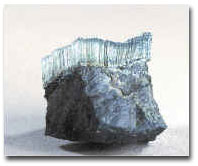
Serpentine rock is apple-green to black and is often mottled with light and dark colored areas. Its surfaces often have a shiny or wax-like appearance and a slightly soapy feel. Serpentine rock is usually fine-grained and compact but may be granular, platy, or fibrous in appearance. The term "serpentine" is commonly used by the general public to refer to the rock type that geologists call "serpentinite." Serpentine rock occurs in central and northern California -- in the Coast Ranges, the Klamath Mountains, and in the Sierra Nevada foothills.
Serpentine rock is primarily composed of one or more of the three magnesium silicate minerals, "lizardite," "chrysotile," and "antigorite." Chrysotile often occurs as fibrous veinlets in serpentine rock. Chrysotile in fibrous form is the most common type of asbestos. Asbestos is a term applied to a group of silicate minerals that readily separates into thin, strong, and flexible fibers that are heat resistant. Lizardite and antigorite do not form asbestos fibers and instead are plate-like in form. Because serpentine often contains some asbestos, and exposure to asbestos fibers have potential human-health consequences, the Air Resources Board adopted regulations in 1990 restricting the use of this rock type as an unpaved road surfacing material. Further information on restrictions for serpentine rock use in California can be obtained by contacting the Air Resources Board, or the local Air Pollution Control District Offices. See our asbestos page for information about asbestos in El Dorado County, a brochure that describes the issue, and related web links.
Serpentinite is considered by geoscientists to be the metamorphosed remains of magnesium-rich igneous rocks, most commonly the rock peridotite, from the earth’s mantle. The mantle is a thick layer of rock just below the earth’s crust. One theory for serpentine formation and occurrence currently in favor with many geoscientists is that peridotite underlying oceanic crustal rocks have been metamorphosed to serpentine in subduction zones that existed at various times in California’s past. A subduction zone is an area where ocean crust rocks run into and slide underneath the edge of a continent. Because serpentine has a much lower density than peridotite, it rose toward the surface along major regional thrust faults associated with the subduction zones.
